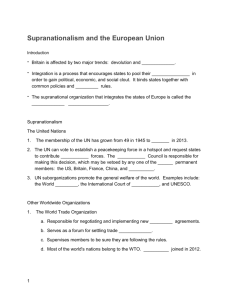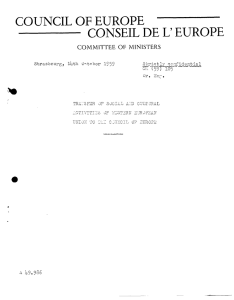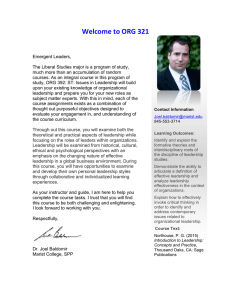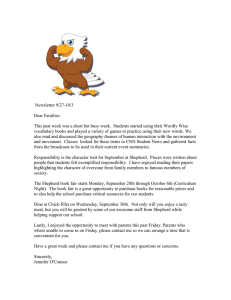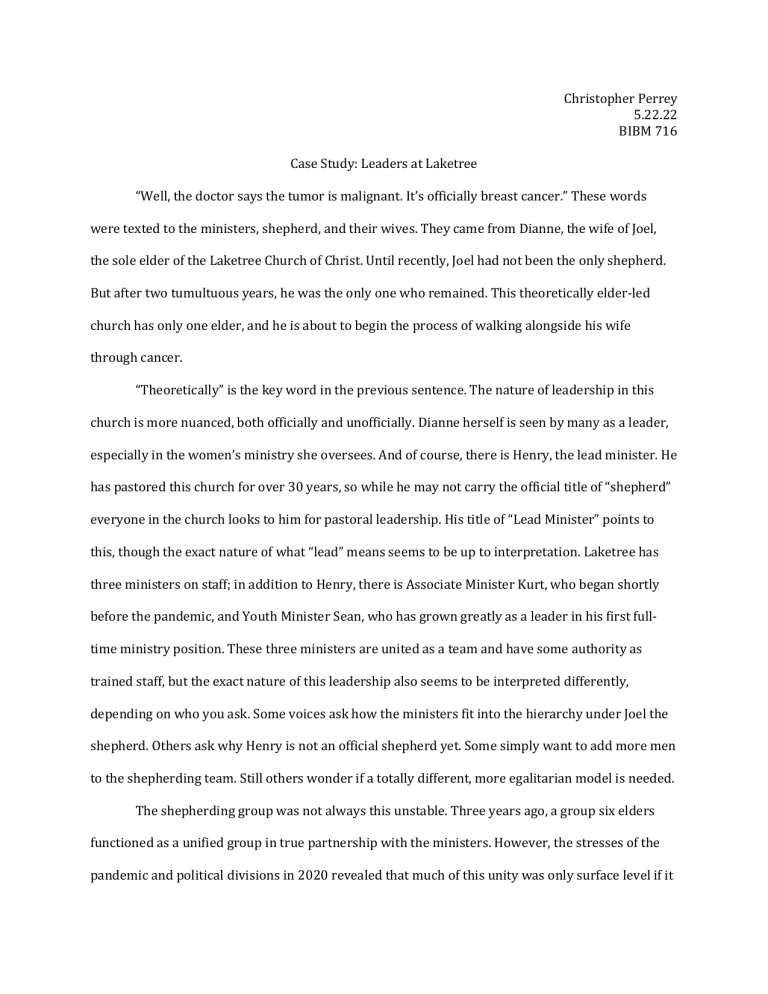
Christopher Perrey 5.22.22 BIBM 716 Case Study: Leaders at Laketree “Well, the doctor says the tumor is malignant. It’s officially breast cancer.” These words were texted to the ministers, shepherd, and their wives. They came from Dianne, the wife of Joel, the sole elder of the Laketree Church of Christ. Until recently, Joel had not been the only shepherd. But after two tumultuous years, he was the only one who remained. This theoretically elder-led church has only one elder, and he is about to begin the process of walking alongside his wife through cancer. “Theoretically” is the key word in the previous sentence. The nature of leadership in this church is more nuanced, both officially and unofficially. Dianne herself is seen by many as a leader, especially in the women’s ministry she oversees. And of course, there is Henry, the lead minister. He has pastored this church for over 30 years, so while he may not carry the official title of “shepherd” everyone in the church looks to him for pastoral leadership. His title of “Lead Minister” points to this, though the exact nature of what “lead” means seems to be up to interpretation. Laketree has three ministers on staff; in addition to Henry, there is Associate Minister Kurt, who began shortly before the pandemic, and Youth Minister Sean, who has grown greatly as a leader in his first fulltime ministry position. These three ministers are united as a team and have some authority as trained staff, but the exact nature of this leadership also seems to be interpreted differently, depending on who you ask. Some voices ask how the ministers fit into the hierarchy under Joel the shepherd. Others ask why Henry is not an official shepherd yet. Some simply want to add more men to the shepherding team. Still others wonder if a totally different, more egalitarian model is needed. The shepherding group was not always this unstable. Three years ago, a group six elders functioned as a unified group in true partnership with the ministers. However, the stresses of the pandemic and political divisions in 2020 revealed that much of this unity was only surface level if it ever truly existed at all. Four of them left for different reasons, theological and political, and in different ways, peacefully and loudly. By the end of the first pandemic year, this elder exodus left only two remaining official shepherds, Joel and John. The following year began with a problematic shepherd search process. All of the recent elder departures had occurred while the church was not fully meeting in person. Whether to start a search when church members could not see one another to discuss the issue face-to-face was a matter of debate, but those in favor of an immediate search won out. The abbreviated process yielded surprising results. First was the potential nomination of two women, including Joel’s wife Dianne. The inclusion of female shepherds would be seen as a large shift, both for members who approved and those who did not, so both women declined. Henry also received numerous nominations but was surprised to learn the other shepherds were not in favor of his inclusion. And of the several other men who were named, only one was willing to take on the responsibility. But adding Phillip to the group would prove to exacerbate rather than solve the leadership crisis. The greatest conflict would come not from new shepherd Phillip, but from John, who had joined the eldership 20 years ago with Joel. Normally quiet in meetings, John became more outspoken in reaction to the possibility of women in leadership, as well as other issues with the direction of the church he had been a leader in for decades. Laketree had been in the process of rethinking its stance on women’s inclusion in ministry for over a decade, but John eventually let it be known that he had never been on board with these decisions despite what he said or implied at the time. These and other factors led him to revert to a more traditional Church of Christ model where the elders are bosses over the ministers. Phillip, not knowing any better, assumed this leadership model as well. However, the elders and ministers had functioned as a team of equals for most of its history, so this attempted shift to a top-down model led to constant friction for most of the year with ministers and one elder who still saw everyone as partners. By the end of 2021, the conflict escalated to the point where it became clear that either John or the ministers and Joel would have to go. Eventually everything blew up with both John and Phillip leaving the leadership and the church. So far in 2022, the leadership has been stable, but not entirely settled. Joel and the ministers are managing, but there have been no official moves to add to or change the leadership structure. Laketree is encountering friction between their Church of Christ traditions and current situational needs. The church has always had a culture of being somewhat non-traditional on many issues but it is now clear that some do not want to move very far. Kurt and Henry have focused much of their recent teaching on the need to listen to what the Spirit is saying in the current moment, including in the possibility of different leadership structures. But after two contentious years, do they have the trust of those who hold to older traditions? Kurt still seems like an outsider to some, and Henry is finding that his 30 years of pastoral experience with this flock is not always enough to persuade them to follow his voice. There have been small steps toward inclusion of other voices. Members who had been on the fringes have stepped into suddenly vacant roles to handle finances and building maintenance. Younger members are more vocal about their hopes for Laketree. Dianne and the ministers’ spouses have been emboldened to speak to where they see pastoral needs. But as mentioned in the beginning, Dianne’s diagnosis will surely create a lack once again as she and Joel must focus on her health. Is Laketree leaderless? The answer depends on who you ask and how they define leadership. Do new leaders need to be appointed, or do current leaders need to be recognized in a more official capacity? How comfortable is this church with a new approach to leadership structures? In the midst of rapidly changing times, how much structural change is too much and how much is simply necessary? The biggest question is not who will have leadership titles, but whether the church as a whole will be led by the Holy Spirit into an uncertain future. So how can Laketree recognize who the Spirit has gifted to do this leading?
